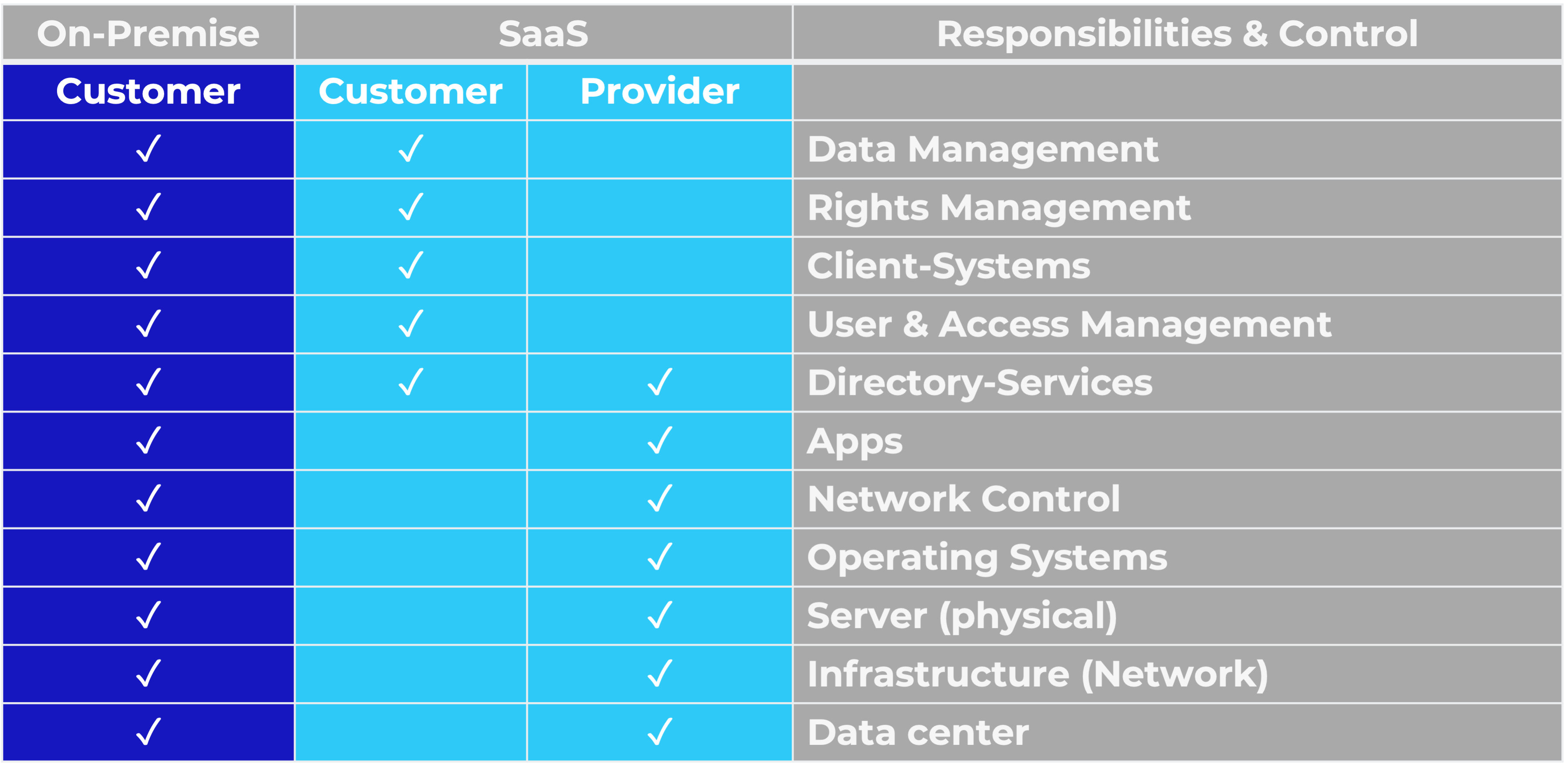2 min read
Why Customer Experience Is Becoming the Ultimate Competitive Edge
Products can be replaced, prices can be compared, but experiences last. In the chapter “Customer...

5 min read
Cloud-based solutions, especially as Software as a Service (SaaS) model, are increasingly popular. There is hardly any company that does not use at least one SaaS application. Does this mean the end of on-premise solutions or do they still have a purpose?
Content:
Software as a Service basically means that a company takes out a subscription for cloud-based software and uses it fully or partially, depending on the subscription type. The provider of the SaaS software takes care of all the support and infrastructure required for the application.
On-premise usually means that a company owns its own servers (or obtains them through a partner) and hosts their developed or purchased software there. Compared to SaaS solutions, the company takes care of all the necessary services and infrastructure itself, which includes maintenance and operation. The internal IT team therefore has a lot more to do to keep everything going.

In the following, I would like to look at various variables and comparisons to support you in your decision for SaaS or on-premise.
Investing in cloud-based software is usually much more affordable than on-premise solutions, because even a complex implementation is not as cost-intensive as the setup of an entire independent infrastructure including individual installations, etc. Only customizations on the application level are possible and necessary (depending on the degree of software-configurability).
In addition, many SaaS providers offer "pay-per-use" models, so you only pay for the functions, services, and processing power that you actually use. Different pricing modules also give you more control over the overall price depending on your requirements.
The choice between monthly or annual billing can further make cost planning easier.
However, you should pay close attention to the contract details, e.g., whether there are service limits, whether the price increases significantly when, for example, more data is processed or more users work with the application. For full cost control you should therefore keep an eye on all parameters of the pay-per-use models.
On-premise servers often require a higher investment sum and are also generally more cost-intensive in terms of maintenance and development, as an IT team is required for infrastructure and application operations.
When comparing the two models, it can therefore be worth calculating the total cost of ownership (TCO) to fully understand the investment perspective.
SaaS is highly scalable with the appropriate resources being made available depending on your usage. Even sudden peaks in utilization are not a problem, especially for so-called "hyperscalers", which respond to peak loads at very short notice.
It should be noted that providers usually make it very easy for customers to scale up, but it is not always easy to scale down. This should be checked and taken into account during the evaluation phase.
On-premise servers can of course be scaled, but local space for existing servers and expansion costs often require a longer planning period and cannot be implemented as quickly. Therefore, scaling at short notice during peak loads is not always possible.
In addition, despite virtualization, it can be more difficult for on-premise servers to efficiently leverage unused resources (unless you yourself offer cloud-based services).
Software as a Service is flexible because it can be customized in addition to the "out of the box" standard models, especially in the enterprise sector. CRM systems, marketing automation platforms, and other larger applications almost always offer options to be modified by the provider, the company's own IT, or external consultants.
Additionally, SaaS in general offers standardized integration options to connect suitable and popular applications. This allows for seamless processes and central data management.
On-premise systems can often be adapted just as well in terms of modification, but modern systems often lack functions that providers of e.g., CRM systems only offer with their SaaS solutions. These include, for example, embedded AI components that cannot be realized on-premise.
It's equally important to update the software regularly and make sure that updates are possible. In addition to the application itself, areas such as the database must be updated regularly. For SaaS solutions, this is done by the provider which prevents the application from implementations that might not have update capabilities, e.g., through a lack of direct database access.
Although maintenance, updates and many other aspects of the software are the responsibility of the provider, SaaS customers do not have to completely relinquish their control. Especially in Europe, companies enjoy full control over their data (and also responsibility) and keep these rights even in the event of contract termination or dunning procedures.
Depending on the application, topics such as admin rights, branding and even taxonomies are also usually controlled and managed by the user. It's worth checking functional and contractual details during evaluation to ensure that the SaaS, for example, properly retains and processes sensitive data.
For better or worse, companies have full 100% control over their applications and data on their own servers. This can have immense benefits when it comes to data protection compliance and control, but it also needs to be managed in an appropriately structured way.
While data protection in the cloud used to be a big issue, it is now widespread that most applications are protected against cyber-attacks via regular updates and two-factor authentication. Furthermore, sensitive data or industries that are subject to specific protection orders, usually have a wide variety of vertical solutions as well as recommendations for secure usage.
In any case - and likewise for on-premise: education, security training and a clear security strategy are the best protection.
I'd like to add that hyperscalers in particular are investing in cloud protection and have passive and active measures in place, including strong security operations centers.
On-premise used to be considered the most secure option for data, but since almost every system is now connected to the Internet in one way or another, hackers can also access local servers and applications through third-party applications, email and of course, human errors. Therefore, agile security measures, regular updates and good corporate education are fundamental to keep the benefits of the on-premise environment.
Do you want to migrate to the cloud? Our experts will support you from evaluating the right solution to implementation and even optimization. Learn more now:
Florian Kiene is Vice President Functional Consulting Microsoft at DIGITALL. He leads a team of business and technical solution architects who design and deliver solutions that fit specific customers’ needs, create added value, and are based on the Microsoft platform. Florian has over 10 years of experience as a Business Architect in the field of Microsoft Business Applications and has held management positions at DIGITALL. His field of expertise includes the digitalization of processes and the optimization of customer journeys.
by Sabine Kirchem
Products can be replaced, prices can be compared, but experiences last. In the chapter “Customer...
by Sabine Kirchem
Customer Relationship Management (CRM) is no longer just a technical discipline but revolves around...
by Sabine Kirchem
There's loads of data out there – but are we truly utilizing it? And more importantly, are we using...